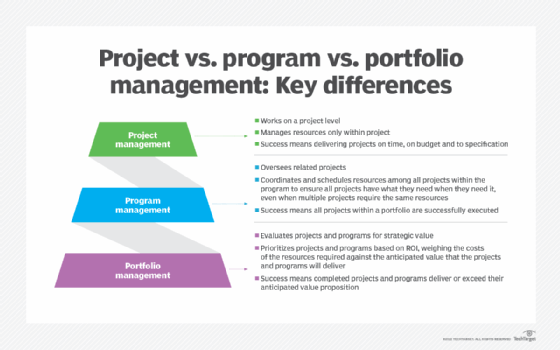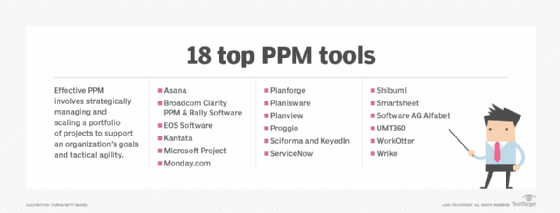Best project portfolio management software and tools in 2025
Project portfolio management software and tools in 2025 promote strategic management of projects and agile tactics. Read our PPM list for guidance on which tools do what.
The tools and software used by enterprises for project and portfolio management are evolving in response to workplace trends, including the rise in working from home, enterprise adoption of new cloud architectures and the integration of AI.
PPM tools are designed to help improve strategic planning across a portfolio of multiple projects. They help ensure a business's entire portfolio of projects is strategically aligned with enterprise goals by prioritizing and sequencing tasks based on estimated costs, benefits, risks and constraints.
PPM tools sit atop project management tools, which help teams coordinate the people, materials and equipment involved in individual projects. PM tools, for their part, have also evolved to support business transformation initiatives by streamlining digital workflows through techniques such as Kanban boards, low-code/no-code development and AI and machine learning.
Here are the vendors cited in this article: Asana; Broadcom Clarity PPM and Rally Software; EOS Software; Kantata; Microsoft Project; Monday.com; Planforge; Planisware; Planview; Proggio; Sciforma and KeyedIn; ServiceNow; Shibumi; Smartsheet; Software AG Alfabet; UMT360; WorkOtter; and Wrike.
Before we get to the list, let's dive into what PPM tools do and how they are evolving.
What are project portfolio management software and tools?
Every company has various projects vying for budget, staff and executive attention. Sometimes these projects complement each other. Sometimes they compete with each other, and in some cases, they do both.
For example, a business team might propose a project to roll out a new SaaS-based offering to customers. The initiative hinges on the completion of work by various groups: The IT department needs to set up a new billing system. The finance department needs to set up a new accounting process for the change in revenue streams. And the legal team needs to work with the finance and business teams to assess the financial impact of different terms and service agreements.
Each one of these projects takes time and money. The company can't sell the new SaaS service until the billing system is set up. But then setting up and integrating the billing system will require having a better understanding of how the new service will be delivered. The IT department must also work with the finance department to determine which tools or services might best align with their desired workflow.
In the old days, people just put all of these things into a spreadsheet to store and share numbers about different scenarios. But things can get complicated as the number of projects, dependencies and metrics grow. This is where PPM tools come in: They provide an integrated whiteboard for each team to share their understanding of their requirements, estimated costs, benefits, risks, timeline and dependencies with the broader organization.
If circumstances change, individuals can update a new assessment into the tool, which gets propagated to enterprise planners and other project managers. PPM can also identify opportunities to spend extra money to push critical projects through that are holding up others -- or to put other projects on hold until a new infrastructure project is complete.

SPM tools vs. APMR tools
In the past, PPM encompassed a broad class of planning tools used primarily by a small group of professional project planners. In response to rapid business and technology change and the need for continuous planning, PPM tools have evolved significantly in recent years. Today's tools have expanded in scope, marrying strategic planning with collaboration processes across business silos, enabling agile project management, incorporating AI and machine learning tools, and integrating with other enterprise business applications, among other innovations. As PPM evolves, two terms often used to describe PPM capabilities are strategic portfolio management (SPM) and adaptive project management and reporting (APMR):
- SPM starts with a big-picture approach to help align enterprise-wide strategy and execution. It includes features to help define key business strategies and desired outcomes. It also provides tools for identifying the talent, technology and activities that can help achieve those outcomes. This can help PPM teams prioritize specific projects and products.
- APMR takes a more bottom-up approach. It includes capabilities that help teams promote continuous collaboration, adapt to changing customer needs and improve execution, informed by various metrics. These tools help align communication and collaboration across many project teams, guiding ongoing project execution and enabling adaptations as required.
Vendors are working to combine both capabilities. Examples include Planisware, Planview, Sciforma and ServiceNow. In some cases, these inclusive tools arose from different acquisitions or development efforts; some work plus additional licensing fees may be required to get SPM and APMR capabilities to work together for a given organization.
Benefits and key capabilities of PPM software and tools
PPM tools and software can boost the value of projects by enabling enterprises to do the following:
- Allocate assets more efficiently.
- Coordinate competing goals from different departments and business teams.
- Drive operational efficiency.
- Improve productivity.
- Minimize project dependency bottlenecks.
- Prioritize the highest-value projects.
- Reduce duplication across projects.
- Spread risks across multiple projects.
The capabilities of PPM tools, as noted, vary widely across vendors and use cases. Generally speaking, PPM tools all offer the following core capabilities to different degrees:
- Improved planning and prioritization of projects using various scenario modeling, strategic roadmap and customer scoring techniques.
- Strategic alignment across teams and departments by using agreed-upon objectives and key results.
- Ability to reflect business goals in the context of specific projects and workflows.
- Resource management tools to estimate the cost of new projects and track the actual time required to improve future estimates.
- Task management capabilities for remote collaboration.
- Financial analysis capabilities to help craft initial estimates and update these based on new circumstances.
- Risk management capabilities for identifying dependencies and resolving issues more quickly.
- Reporting capabilities for assessing progress and identifying obstacles.

Top PPM tools and software
Here is a selection of leading PPM tools and software vendors, listed alphabetically, with brief takes on what the products do and how they are reviewed by by PPM experts, including users and consultancies such as Gartner and Forrester. The list was compiled based on internet research. Published rankings from Gartner's 2024 Magic Quadrant for APMR products and Forrester's 2024 Wave on SPM tools are also cited.
Asana
Named a Leader in Gartner's 2024 Magic Quadrant on APMR tools, Asana was singled out by the consultancy for the platform's translation into many languages, its investment in AI features and the high marks it gets for customer satisfaction. Cautions from Gartner's report include a business model that relies on growth to offset an operating deficit and the fact that enterprises will need to subscribe to higher-priced plans to get all the PPM features they'll need.
Users on G2, the software review platform, cite the platform's flexible framework for managing projects, ease of use and integration capabilities with other tools and services such as Slack, Google Calendar and Microsoft Teams as plusses. Among the predominantly positive reviews on G2, however, some note that the interface can be overwhelming and complex for new users.
Broadcom Clarity PPM and Rally Software
Broadcom Clarity supports enterprise-wide PPM, while Rally adds the ability to connect projects with value stream management capabilities. This combination promises to redefine how an enterprise can plan, execute and track work. Clarity can help improve strategic planning and prioritize investments, and it supports project tracking. Rally helps align these with Agile development processes across Broadcom's extensive development and testing tools collection.
Forrester's 2024 SPM Wave report, which places Broadcom in its Leader category, noted that customers like the platform's ease of use, training and customer community. The report deemed Broadcom's AI capabilities "still in the early stages." The product, a good fit for larger organizations, services a wide range of industries and, according to Forrester, is well-suited for organizations undergoing agile transformation. The tool also supports extensive roadmapping capabilities to help align long-term plans with tactical execution. It also can help organize a collection of projects into a hierarchy to improve management, reporting and governance.
EOS Software
The EOS Software ITPM platform was designed to coordinate the work of strategy realization officers, program managers and enterprise architects. It has several features for adaptive planning, application portfolio management, scenario planning and resource management. It is a solid option for improving the connectivity between strategic planning and new IT services.
EOS Software partnered with Planisware, another PPM vendor, to enhance IT integration across both tools. The tight integration with IT systems helps visualize connections between business strategies and applications, services or other IT resources.
Kantata
Kantata Professional Services Cloud, formerly known as Mavenlink + Kimble, is a PPM tool purpose-built for professional services firms. Features include task management, time tracking, resource management, financial management, and reporting and analytics, as well as real-time collaboration tools and integration with business applications such as CRM, ERP and HR systems.
Microsoft Project
Known for its project management capabilities, Microsoft Project is also used for project portfolio management in combination with the vendor's Microsoft Project server/Project Online repositories and its Power BI tool. The tool tends to generate diverging options, with some users saying the software's drag-and-drop functionality makes it relatively easy to use and others warning of a steep learning curve.
Monday.com
Monday.com's APMR capability aims to improve project and work management in hybrid office scenarios. Named a Leader in Gartner's 2024 APMR MQ, the product provides several templates to help organizations quickly get started. An extensive suite of collaboration tools can help organizations coordinate more efficiently across the office or the world. These tools promise to help boost a team's alignment, efficiency and productivity through customized workflows. Organizations can also create customizable dashboards to improve decision-making. It also supports project management, portfolio management, project planning and risk management capabilities. The product is hosted on Amazon Web Services infrastructure.
Planforge
Planforge, formerly known as ONEPOINT Projects, is focused on APMR capabilities. One vital feature is the tool's hybrid approach: It supports both traditional waterfall and Agile project methodologies. This enables enterprises to combine both approaches for different use cases. It supports various dashboards and charts to surface project and portfolio progress in real time and includes connectors for various popular tools, including Excel, Slack, Jira, Confluence, SAP and Microsoft Project.
Planisware
Planisware provides a single shared view across project and portfolio management functions. Named a Leader in Gartner's 2024 APMR MQ, the vendor's Planisware Orchestra product combines strong dashboard capabilities with industry best practices. Gartner lists its market responsiveness and overall viability among its strengths. Forrester's 2024 SPM Wave report places the vendor in its Leader category, citing its powerful strategy planning and business architecture. It has good support for both APMR and SPM. It also supports process automation to help prioritize initiatives, organize resources and coordinate execution. It is widely used by larger companies in industries like financial services, life sciences and manufacturing.
Planview
Planview, named a Leader in the Gartner 2024 APMR MQ and Forrester's 2024 SPM Wave, is one of the larger PPM vendors on this list. It supports a comprehensive set of APMR capabilities through Planview PPM Pro and Planview AdaptiveWork (formerly Clarizen) enabling businesses to pivot quickly when needs change.
Planview also supports SPM capabilities. The company has grown through many acquisitions, including Troux, Projectplace, Innotas, LeanKit, Clarizen, Changepoint, Spigit, Tasktop and Enrich, and it has been integrating these new capabilities into its core platform. The combination of these tools can help connect strategic planning with enterprise architecture. According to Forrester, Planview's platform and core portfolio management capabilities are its big differentiators, enabling companies "to link planning and delivery functions as well as business architecture and APM [application portfolio management] capabilities."
Proggio
Proggio is focused on APMR capabilities that support broad project and work management. It supports a novel approach to data presentation that uses connected layers to create a digital map of project and portfolio progress. Users can zoom out to view the entire portfolio, zoom in to explore project workstreams and zoom in further to examine individual activities or specific bottlenecks. This simplifies navigation, and users can easily make changes when updates are identified.
Sciforma and KeyedIn
Sciforma acquired KeyedIn in March 2023. Prior to the combination, both companies separately earned Leader status in Gartner's APMR ranking. Sciforma Vantage, the company's PPM product, was called out for its overall viability, combining PPM with collaborative work management. This helps organizations formulate strategy, prioritize projects, track progress and manage projects within a single connected tool. The core Sciforma platform has been widely used across several industries, including biotech, financial services, healthcare, manufacturing and telecommunications.
KeyedIn Enterprise supports enterprise PPM, SPM and adaptive project management. Its enterprise tools help model enterprise initiatives or improve digital transformation efforts. Essential capabilities support strategic alignment, portfolio selection and prioritization, and resource capacity planning. It integrates with various tools, including Jira, Microsoft Project, Microsoft Power BI, Salesforce and QuickBooks.
ServiceNow
ServiceNow has a strong presence in cloud-based IT service management. It recently rebranded its IT business management offering as ServiceNow Strategic Portfolio Management. Its strength lies in connecting business planning with actual IT infrastructure. This takes advantage of ServiceNow's extensive monitoring and reporting capabilities. The offering supports performance analytics, demand management, resource management and innovation management. It can also help teams simulate and compare potential outcomes with scenario planning. It can align new plans with application performance management to monitor the effects of new programs on IT infrastructure. An additional advantage is the ability to automatically implement new ideas through ServiceNow's low-code tools and assess the results before scaling them up. The ServiceNow tool earned Leader status in Forrester's Q2 2024 Wave on strategic portfolio management tools.
Shibumi
Shibumi is provisioned as a cloud-based PPM service. The company highlights its scalability, accessibility, and ability to provide a single source of truth with real-time visibility. It includes tools that surface both financial and nonfinancial metrics and results. A template library helps executives make informed decisions through support for program status and KPIs.
One powerful feature is direct integration with various robotic process automation tools from Automation Anywhere, Blue Prism and UiPath. It also supports AI integrations with Dataiku, DataRobot and IBM Watson to help improve predictions and planning. These integrations help speed up the time to value to help teams quickly jumpstart deployment and adapt to new goals.
Smartsheet
Smartsheet started out as a better spreadsheet for collaboration. Over the years, it has expanded into various areas, including PPM. It provides a variety of customizable templates that help companies and departments get started with individual projects and then connect them into portfolios. It supports an extensive set of integrations into tools from ServiceNow, Google, Microsoft, Slack, Salesforce, Jira and dozens of other companies.
One of its core strengths is its simplicity. The familiar spreadsheet-like interface provides many ways for business users to extend it to different use cases. This helps teams bring in data from third-party apps, automate processes and customize workflows.
Software AG Alfabet
Software AG has been building data and software development tools since 1969 and acquired Alfabet PPM solutions in 2013. It combined these tools with its other ARIS process modeling products and has continued enhancing its PPM capabilities' breadth and depth. The result is better linkage between the interdependent perspectives of IT, business, finance and risk, giving PPM teams the ability to better understand the impact of new ideas. It also supports built-in enterprise architecture capabilities.
Teams can describe IT systems in terms of application, information and technical layers. This knowledge can also guide the development of standards to harmonize projects and infrastructure and to reduce operational costs. At the same time, it helps less technical users create reports, explore the impact of new ideas and update plans. It comes with an extensive set of AI and machine learning capabilities for discovering portfolio shortcomings.
UMT360
UMT360 Strategic Portfolio Manager was specifically designed to help drive business transformation. It is a cloud-based platform with separate modules for analytics and enterprise integration. The company acquired FIOS Insight in 2021, which added enterprise architecture capabilities for analyzing existing IT systems and planned changes. It also supports a collection of industry reference models to guide new projects, with best practices for the appropriate architecture.
One essential aspect is support for packaged applications (called Accelerators) that help customers get started quickly with a base level of capability -- laying the groundwork for adding more modules later. These modules support what-if analysis, resource planning and benefits realization. The platform also supports an extensive array of integrations with other tools, including Jira, Oracle Fusion Cloud Financials, SAP and ServiceNow.
WorkOtter
WorkOtter is a cloud-based PPM tool with a powerful set of APMR capabilities. A core strength is that it provides templates and best practices that help teams follow project management industry best practices. It can deliver prescriptive guidance to help projects and portfolios meet goals and adapt when required. Named a Visionary in the Gartner 2024 APMR MQ, the product also supports a variety of financial management capabilities to help evaluate tradeoffs across labor, capital expenses, operational expenses and quoted versus actual costs.
Wrike
Wrike focuses on project management and collaboration, providing a wide range of features that include task management and resource management. Named a Visionary in the Gartner 2024 APMR MQ, the product integrates with various platforms and tools and gets high marks for strong reporting and analysis tools. User reviews report that the large range of features can be overwhelming for people unfamiliar with project management tools.
How to choose the best PPM tool or software for your business
Project and portfolio management is a vast field with considerable variation across its range of tools. Where to begin?
It is probably helpful to start by inventorying what business managers are already using to manage projects. If managers are happy using Excel, it may make sense to shortlist other relatively simple PPM tools. If you have an extensive SaaS portfolio, exploring some of the other SaaS-based PPM offerings may make sense.
Many of the most popular PPM tools make it easy to get started and kick the tires in a short period. Trialing the tools can give you an idea of how they work and how they might simplify project planning and management, as compared with your existing approach. Testing tools can also help define and refine the capabilities your business needs.
Once your team has identified what capabilities they are looking for, then you can start to explore some of the more sophisticated offerings. It may be that the essential tools are good enough for the long haul. Even relatively simple ones have reported very high ROIs, and the ease of use can boost adoption.
However, it is also worth investigating how some of the more sophisticated tools are pushing the cutting edge. It is also worth keeping an eye on upgrades to your favorite options. New AI capabilities are rapidly evolving. These can both simplify the project and portfolio management experience while simultaneously ingesting and contextualizing data from more sources.
Editor's note: This article was updated in November 2024 to reflect changes in the PPM market.
George Lawton is a journalist based in London. Over the last 30 years, he has written more than 3,000 stories about computers, communications, knowledge management, business, health and other areas that interest him.







